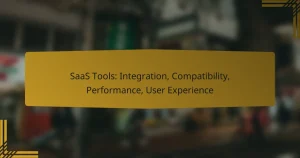Less.re is a powerful tool designed to maximize efficiency for Canadian businesses by automating operations and providing real-time data insights. With features like task management, time tracking, and seamless API integration, it empowers organizations to streamline workflows and make informed decisions quickly. Its affordability and robust functionality make it an ideal choice for companies aiming to enhance productivity without exceeding their budget.
SaaS Interface: User Feedback, Customer Preferences and Design Insights
User feedback is vital for improving SaaS interfaces, as it guides design choices and feature enhancements. By understanding customer preferences through structured feedback mechanisms, companies can create more intuitive experiences…
Less.re: Customization Capabilities, Competitor Comparison and Market Positioning
Less.re is designed specifically for Canadian users, offering a user-friendly interface and localized support that enhance the overall experience. With robust customization capabilities, including customizable dashboards and user-defined workflows, it…
SaaS Long-Term Costs: Evaluation, Growth and Financial Planning
Understanding the long-term costs of Software as a Service (SaaS) is crucial for businesses looking to optimize their financial planning. Beyond the initial subscription fees, ongoing expenses such as support,…
SaaS Products: Designing User-Friendly Interfaces and Best Practices
Designing user-friendly interfaces for SaaS products is essential for enhancing user engagement and satisfaction. By focusing on intuitive navigation, consistent design, and accessibility, companies can create experiences that resonate with…
User Experience: Impact on SaaS Adoption Rates and Startups
User experience (UX) is a pivotal factor influencing SaaS adoption rates, particularly for startups in a competitive landscape. A well-designed, intuitive interface combined with reliable performance and effective customer support…
User Authentication: Role, Methods and Security Enhancement
User authentication is a critical process that verifies the identity of users accessing systems or data, employing methods ranging from traditional passwords to advanced biometric techniques. By effectively implementing user…
Less.re: Customization Role, Niche Markets and User Engagement
Less.re is revolutionizing user engagement in Canada by delivering customized experiences that resonate with local audiences. By offering personalized content and interactive tools, it creates a dynamic platform for meaningful…
Less.re vs Competitors: Security Features Comparison
Less.re stands out in the competitive landscape of digital communication platforms by offering advanced security features that prioritize user safety and data protection. With a focus on end-to-end encryption, two-factor…
Integration Capabilities: Assessment, Evaluation and Business Needs
Integration capabilities for SaaS tools are crucial for facilitating efficient data exchange and enhancing operational functionality within businesses. By assessing integration needs, organizations can identify gaps in their current systems…
SaaS Customer Support: Best Practices, Insights and Industry Standards
In the competitive landscape of SaaS, delivering exceptional customer support is crucial for success. By adopting best practices such as proactive communication, personalized interactions, and leveraging technology, companies can significantly…
How can Less.re improve efficiency in Canadian businesses?
Less.re enhances efficiency in Canadian businesses by streamlining operations through automation, real-time data insights, and seamless integration with existing systems. These features help organizations reduce time spent on repetitive tasks and make informed decisions quickly.
Automation of repetitive tasks
Less.re automates routine tasks, allowing employees to focus on higher-value activities. For instance, it can handle data entry, report generation, and email responses, which can save businesses several hours each week.
To implement automation effectively, identify tasks that are time-consuming and repetitive. Start with a few key processes and gradually expand automation as you assess its impact on productivity.
Real-time data analytics
With real-time data analytics, Less.re provides businesses with immediate insights into their operations. This capability enables companies to monitor performance metrics and make timely adjustments to strategies.
Utilizing dashboards and visual reports can help teams quickly grasp complex data. Regularly review these analytics to identify trends and areas for improvement, ensuring that decisions are data-driven.
Integration with existing tools
Less.re integrates smoothly with popular business tools, such as CRM and project management software. This compatibility allows for a unified workflow, reducing the need to switch between applications.
When integrating, ensure that data flows seamlessly between systems. Conduct testing to confirm that all tools communicate effectively and that users can access necessary information without delays.
Customizable workflows
Customizable workflows in Less.re enable businesses to tailor processes to their specific needs. This flexibility allows teams to design workflows that align with their operational goals and improve efficiency.
Start by mapping out existing processes and identifying bottlenecks. Use Less.re’s customization features to streamline these workflows, making adjustments as necessary based on team feedback.
Collaboration features
Less.re offers collaboration tools that enhance communication among team members. Features like shared documents, task assignments, and real-time messaging facilitate teamwork and keep projects on track.
Encourage team members to use these collaboration features regularly to foster a culture of open communication. Set clear expectations for responsiveness to ensure that collaboration leads to effective outcomes.
What features does Less.re offer for maximizing productivity?
Less.re provides a suite of features designed to enhance productivity, including task management, time tracking, reporting, and API access. These tools help users streamline workflows, gain insights, and integrate with other applications for improved efficiency.
Task management system
The task management system in Less.re allows users to create, assign, and prioritize tasks easily. It supports collaboration by enabling team members to comment and share updates, ensuring everyone stays aligned on project goals.
Users can categorize tasks based on urgency or project type, helping to focus efforts where they are most needed. This feature is particularly useful for teams managing multiple projects simultaneously.
Time tracking capabilities
Less.re's time tracking capabilities enable users to log hours spent on various tasks and projects accurately. This feature is essential for understanding productivity levels and identifying areas for improvement.
With options for manual entry and automatic tracking, users can choose the method that best fits their workflow. Regularly reviewing time logs can help teams optimize their schedules and allocate resources more effectively.
Reporting and insights dashboard
The reporting and insights dashboard provides a visual overview of productivity metrics, allowing users to analyze performance trends over time. This feature helps in identifying bottlenecks and assessing the effectiveness of different strategies.
Users can customize reports to focus on specific projects or time periods, making it easier to present findings to stakeholders. Regularly utilizing this dashboard can lead to informed decision-making and enhanced operational efficiency.
API access for developers
Less.re offers API access, allowing developers to integrate its features with other applications and systems. This flexibility enables organizations to tailor the platform to their specific needs and workflows.
Using the API, developers can automate tasks, synchronize data, and create custom solutions that enhance productivity. This capability is particularly valuable for businesses looking to streamline their operations and improve overall efficiency.
How does Less.re compare to other SaaS tools in Canada?
Less.re stands out among SaaS tools in Canada by offering a unique blend of affordability and functionality tailored to local businesses. Its competitive pricing and robust features make it an appealing choice for companies looking to maximize efficiency without overspending.
Pricing structure vs. competitors
Less.re typically offers a subscription model that is more affordable than many competitors in the Canadian market. While other SaaS tools may charge upwards of CAD 100 per month, Less.re often provides plans starting around CAD 50, making it accessible for small to medium-sized enterprises.
Additionally, Less.re frequently runs promotions or discounts for annual subscriptions, which can further reduce costs. Businesses should compare the total cost of ownership, including any hidden fees, to ensure they are getting the best value.
Feature set comparison
When comparing feature sets, Less.re includes essential tools such as project management, collaboration features, and analytics, which are often found in higher-priced alternatives. Many competitors may offer similar functionalities but lack the seamless integration that Less.re provides with other popular software used in Canada.
For example, while some tools focus heavily on project tracking, Less.re balances this with user-friendly interfaces and customizable dashboards, allowing teams to tailor their experience. This flexibility can lead to improved productivity and user satisfaction.
User experience ratings
User experience ratings for Less.re are generally positive, with many users praising its intuitive design and ease of use. In various Canadian software review platforms, it often scores above average compared to competitors, particularly in customer support and onboarding processes.
However, potential users should consider reading recent reviews to gauge current user sentiments, as experiences can vary based on specific needs and use cases. Engaging with trial versions can also provide insights into how well the software meets individual business requirements.
What are the prerequisites for implementing Less.re?
To implement Less.re effectively, organizations need to ensure they meet specific system requirements, provide adequate team training, and have the necessary integration capabilities. Addressing these prerequisites will streamline the adoption process and enhance overall efficiency.
System requirements
Less.re requires a robust IT infrastructure to function optimally. This typically includes a modern operating system, sufficient processing power, and adequate memory to handle data processing tasks. Generally, systems should have at least 8GB of RAM and a multi-core processor for smooth operation.
Additionally, ensure that your network bandwidth can support the data flow without significant latency. A stable internet connection with speeds of at least 25 Mbps is recommended for cloud-based functionalities.
Team training needs
Effective use of Less.re hinges on comprehensive training for team members. Training should cover the software's features, best practices, and troubleshooting techniques. Consider allocating several hours to a few days for initial training sessions, depending on the team's familiarity with similar tools.
Encouraging ongoing education through workshops or online courses can further enhance team proficiency. Regularly scheduled refresher courses can help keep skills sharp and ensure that the team stays updated on new features or updates.
Integration capabilities
Less.re must integrate seamlessly with existing systems to maximize efficiency. Check compatibility with current software tools, such as project management platforms and communication apps. Most organizations benefit from integrations that allow data sharing and workflow automation.
Evaluate the APIs and plugins available for Less.re to ensure they align with your operational needs. A well-planned integration strategy can significantly reduce manual data entry and streamline processes, ultimately saving time and resources.
What are the pricing plans for Less.re?
Less.re offers flexible pricing plans designed to accommodate various user needs. The options include monthly subscriptions, annual discounts, and a free trial to help users evaluate the service before committing.
Monthly subscription options
Less.re provides a straightforward monthly subscription model that allows users to pay on a month-to-month basis. This option is ideal for those who prefer flexibility or are unsure about long-term commitments. Pricing typically ranges from low to mid double digits in USD, depending on the features selected.
Users can choose from different tiers, each offering varying levels of access to tools and resources. It's advisable to review the specific features included in each tier to ensure it meets your needs.
Annual pricing discounts
For users looking to save, Less.re offers significant discounts for annual subscriptions. Opting for an annual plan can reduce costs by approximately 10-20% compared to monthly payments. This is a practical choice for businesses or individuals who plan to use the service long-term.
When considering an annual plan, evaluate your usage patterns to ensure it aligns with your needs. The upfront payment may seem substantial, but the savings can be worthwhile over time.
Free trial availability
Less.re provides a free trial period, allowing potential users to explore the platform without financial commitment. This trial typically lasts for a week or two, giving users ample time to assess the features and usability.
During the trial, take advantage of all available tools to determine if the service meets your requirements. Remember to cancel before the trial ends if you decide not to continue, to avoid being charged for the subscription.
How can businesses measure the impact of Less.re on efficiency?
Businesses can measure the impact of Less.re on efficiency by tracking key performance indicators (KPIs) such as time savings, cost reductions, and productivity improvements. By comparing these metrics before and after implementing Less.re, organizations can gain insights into its effectiveness.
Key performance indicators (KPIs) to track
To effectively measure the impact of Less.re, businesses should focus on KPIs such as operational costs, employee productivity, and turnaround times. For example, a reduction in operational costs by 15-30% can indicate improved efficiency. Tracking these metrics over time allows for a clear assessment of performance changes.
Tools and methods for measurement
Utilizing tools like project management software, time-tracking applications, and financial analysis platforms can facilitate the measurement of efficiency gains. Regular surveys and feedback from employees can also provide qualitative data on how Less.re affects their workflow. Combining quantitative and qualitative data offers a comprehensive view of its impact.
Interpreting the results
When interpreting the results, businesses should consider external factors that may influence efficiency, such as market conditions or changes in team dynamics. Analyzing trends over several months can help distinguish between short-term fluctuations and long-term improvements. It is crucial to contextualize the data to make informed decisions about future strategies.






